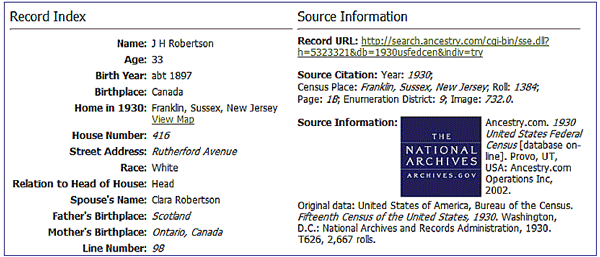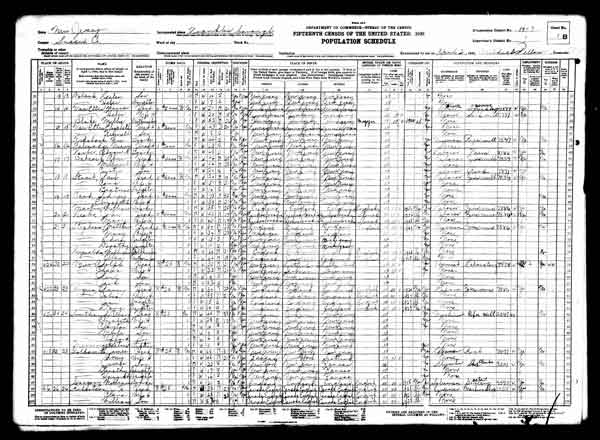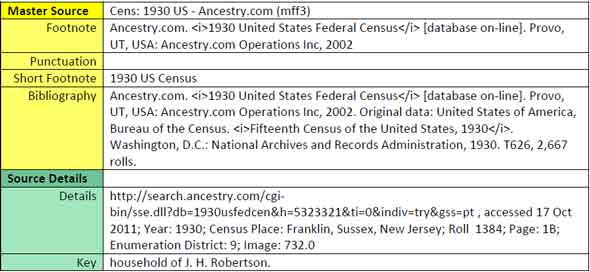Problems with Tom Holden's MyFreeForm Template
As noted elsewhere, Tom Holden conducted a biased "study" of three templates (that included one he created, MyFreeForm). Rather arrogantly, he declares his to be superior (he's since tried to remove the excessive use of superlatives when describing his template). Besides the obvious bias, there are many problems evident in his so-called "study." Here are a few examples:
1. Mr. Holden begins his "study" by citing a citation - not a source document! In doing so, he breaks one of the cardinal rules of essentially all citation systems: always cite the actual source (when it is available) and NEVER cite another reference to it. (The only exception is when the actual source is not available and, in that case, it should be noted that you are not citing the actual document but a reference to it.) Specifically, Mr. Holden's "study" used the following information from Ancestry.com (note: it appears as if he used one or more screen captures of this information for his report; however, the following could not be found on Ancestry and they may have changed the format [but not the content] of this information):
 |
As the scanned image of the actual census record was obviously available, he should have used that. Here's a copy:
 |
| Click here to view the full-sized census record. |
2. He then states, "Now I think the Ancestry Source Information, Source Citation and Record URL taken together is comprehensive and, by and large, complies with the principles of Evidence Explained for content, even though it is not necessarily in a pattern corresponding to any one of the built-in source templates or either of the custom templates tried in this report." It is evident that Mr. Holden believes he is following the "principals of Evidence Explained" to determine the content that should be put into his free form template. If that's the case, then why doesn't he just use one of the pre-existing Evidence Explained Templates or, if he doesn't like those, why not create his own to follow whatever criteria he uses? That may be because he wants his template to be "compatible" with all other genealogy programs. The problem is, most genealogy programs make a mess of citations too.
3. Mr. Holden suggests that he is a lumper when he offers the following example to show how he entered the information from Ancestry's citation (and not the actual census record) into his template:
 |
In examining this entry, it is obvious that a considerable amount of information is entered into each field. In addition, the same information is entered multiple times (which is exactly the opposite what a real lumper would do and contrary to what templates should be used for in the first place - to reduce the amount of data entry required and, therefore, also reduce potential for error). It is clear that Tom Holden requires that DIFFERENT information must be entered to generate output three different ways. In essence, he has crammed three DIFFERENT templates into one, and yet all of this information refers to the SAME source! So much for making a "template that sings . . ."
The excessive redundancy in his data entry requirements is very clear. For example, "1930 United States Federal Census" is entered twice and is also listed as the "Fifteenth Census of the United States, 1930." The problem is that the MyFreeForm template requires the entry of three different types of "footnotes" (e.g., footnote, short footnote, and bibliography). Once again, Tom Holden requires users to manually create the same citation three times - every time you use his template. Of course, there is no need for three different types of "footnotes" in the first place and, even if there were, then there should be a mechanism by which each can be created automatically by a template that requires data to be entered just once - not three times.
Then there's the matter that considerable information is included that is not meaningful for finding the source again (this is also one of the hallmark signs of splitters and not lumpers). As noted in his "study," the information for this citation came from Ancestry.com and yet he mentions the National Archives, microfilm roll numbers, image numbers, the physical location of Ancestry.com (including city, state, and country), and even the number of microfilm rolls (2,666 of which do not contain the information found on this census record) - none of these items are needed in a citation. This is, in fact, an example of extreme splitting (not lumping). To emphasize this point, when examining a traditional bibliography or reference list (as would appear in a book, journal, or other scholarly material), is the name of the library, floor number, shelf number, ISBN, and Dewey Decimal Number included in the citation? If you obtained a book, through an interlibrary loan or obtained an electronic copy of a scholarly article that your local library ordered from another library, would you list either or both of those libraries in a citation? Absolutely not! No other citation system would require such an extraordinary amount of information as it is not necessary! Of course, the amount of time and energy required to obtain and enter this voluminous amount of information is enormous, not to mention the countless decisions required to determine what, precisely, information should be entered in the first place! These problems have been directly addressed by Simple Citations, and which Tom Holden's MyFreeForm completely ignored! It's much more likely that genealogists and Family Historians would rather be doing the "fun stuff" - looking for more information about their ancestors than spending a lifetime entering needless information into a database.
4. As noted above, Mr. Holden is concerned with entering three different types of "footnotes" when producing the output of those footnotes should be left up to the computer to do, behind the scenes. Then there is also another extremely significant problem associated with three different types of footnotes - what information, exactly, is required in each one? How does one determine what information must be included? In light of the extraordinarily diverse sources that must be documented, how does anyone (including even the most experienced genealogist) decide what information is required and in what order should that information should be cited? How does anyone maintain consistency between citations? The answer, of course, is that these things can't be done with a "free form" template without spending an enormous amount of time trying to remember exactly how other sources were cited.
5. The fields of the MyFreeForm template also contain formatting tags such as <i></i>. Is your average home user now expected to learn html? How are users supposed to know when to use these tags? Under what conditions are these tags used? Again, this presents a nightmarish situation for essentially all users.
6. Genealogical citations are usually divided into two parts - "Master Source," which contains information about the source itself, and "Source Details," which contains information about the individual (sometimes individuals) referenced by that source. The MyFreeForm template does some very strange (and confusing) things with that: instead of focusing on data, the "Master Source" is supposed to be filled with three different types of completed citations. In addition, there's the rather bizarre inclusion of "punctuation" - which has absolutely nothing to do with the source. (Punctuation for citations should also be handled, behind the scenes, by the computer. Indeed, many commercial citation databases handle punctuation this way.)
The fields under "Source Details" are also extremely ambiguous. What data, if any, should be included under "Details?" What is a "key?"
By now it should be very evident that Tom Holder's MyFreeForm isn't superior at all. If anything, it's liable to give users a superior headache and provides a very good look at how not to cite a source.
